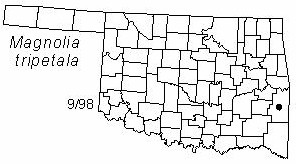Tree to 10 m (30 ft) tall and 15 cm (6 in) diameter, with an open crown. Bark thin, smoothish, light gray. Twigs thick, shiny brown, becoming glabrous. End bud pointed, purplish, about 2.5 cm (1 in) long. Leaves alternate, obovate, crowded near ends of twigs, 25-40 cm (10-16 in) long and 13-20 cm (5-8 in) wide, entire, short-pointed, green and glabrous above, silky-hairy below when young but later becoming glabrous. Flowers single at ends of twigs, 18-25 cm (7-10 in) wide, with pale green sepals and white petals, blooming in Spring. Fruits conelike, oblong, 6-10 cm (2.4-4 in) long, composed of numerous follicles that split open in the late Summer to release two seeds.
Distribution: Found in scattered locations throughout the Appalachians, Ozarks, and Ouachitas.
Habitat: Moist forested valleys. In Oklahoma, it is only found in the valley of Cucumber Creek in eastern LeFlore County.
NWI status: FAC
Comment: Magnolia honors the French botanist and horticulturist Pierre Magnol; tripetala refers to the three large petaloid sepals. The flowers have numerous petals which are smaller than the sepals.
Distribution in Oklahoma: 
BACK
NEXT
RETURN TO INDEX
Last update: 9/14/99
 Go to Oklahoma Biological Survey Home Page
Go to Oklahoma Biological Survey Home Page
 Disclaimer
Disclaimer